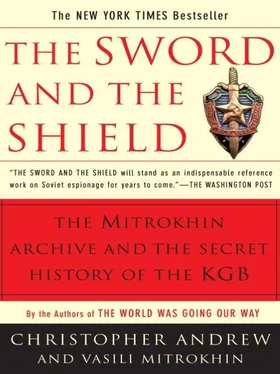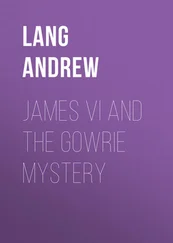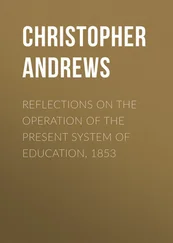When Solzhenitsyn began writing in the 1950s, he told himself he had “entered into the inheritance of every modern writer intent on the truth”:
I must write simply to ensure that it was not forgotten, that posterity might some day come to know of it. Publication in my own lifetime I must shut out of my mind, out of my dreams.
Just as Mitrokhin’s first notes were hidden in a milk-churn beneath his dacha, so Solzhenitsyn’s earliest writings, in minuscule handwriting, were squeezed into an empty champagne bottle and buried in his garden. 26After the brief thaw in the early years of “de-Stalinization” which made possible the publication of Solzhenitsyn’s story of life in the gulag, One Day in the Life of Ivan Denisovich, he waged a timeconsuming struggle to try to prevent the KGB from seizing his other manuscripts until he was finally forced into exile in 1974. 27It did not occur to Mitrokhin to compare himself with such literary giants as Bulgakov and Solzhenitsyn. But, like them, he began assembling his archive “to ensure that the truth was not forgotten, that posterity might some day come to know of it.”
THE KGB FILES which had the greatest emotional impact on Mitrokhin were those on the war in Afghanistan. On December 28, 1979 Babrak Karmal, the new Afghan leader chosen by Moscow to request “fraternal assistance” by the Red Army which had already invaded his country, announced over Kabul Radio that his predecessor, Hafizullah Amin, an “agent of American imperialism,” had been tried by a “revolutionary tribunal” and sentenced to death. Mitrokhin quickly discovered from the files on the war which flooded into the archives that Amin had in reality been assassinated, together with his family and entourage, in an assault on the Kabul presidential palace by KGB special forces disguised in Afghan uniforms. 28
The female clerks who filed KGB reports on the war in the archives after they had been circulated to the Politburo and other sections of the Soviet hierarchy had so much material to deal with that they sometimes submitted to Mitrokhin thirty files at a time for his approval. The horrors recorded in the files were carefully concealed from the Soviet people. The Soviet media preserved a conspiracy of silence about the systematic destruction of thousands of Afghan villages, reduced to forlorn groups of uninhabited, roofless mud-brick houses; the flight of four million refugees; and the death of a million Afghans in a war which Gorbachev later described as a “mistake.” The coffins of the 15,000 Red Army troops killed in the conflict were unloaded silently at Soviet airfields, with none of the military pomp and solemn music which traditionally awaited fallen heroes returning to the Motherland. Funerals were held in secret, and families told simply that their loved ones had died “fulfilling their internationalist duty.” Some were buried in plots near the graves of Mitrokhin’s parents in the cemetery at Kuzminsky Monastery. No reference to Afghanistan was allowed on their tombstones. During the Afghan War Mitrokhin heard the first open criticism of Soviet policy by his more outspoken colleagues at Yasenevo. “Doesn’t the war make you ashamed to be Russian?” an FCD colonel asked him one day. “Ashamed to be Soviet, you mean!” Mitrokhin blurted out.
When Mitrokhin retired in 1984, he was still preoccupied with the Afghan War. He spent the first year and a half of his retirement sorting through his notes, extracting the material on Afghanistan, and assembling it in a large volume with a linking narrative. Despite Gorbachev’s call for glasnost after he became Party leader in 1985, Mitrokhin did not believe the Soviet system would ever allow the truth about the war to be told. Increasingly, however, he began to think of ways of transporting his archive to the West and publishing it there.
One novel method suggested itself on May 28, 1987, when a single-engine Cessna piloted by a nineteen-year-old West German, Matthias Rust, crossed the Finnish border into Soviet airspace and flew undetected for 450 miles before landing in Red Square. After an hour of confusion, during which Kremlin security guards wondered whether Rust was an actor in a film, he was taken away to the KGB’s Lefortovo Prison. Mitrokhin briefly considered but quickly abandoned the idea of using a microlite from a KGB sports club to fly with his archive in the opposite direction to Finland.
The most practical of the various schemes considered by Mitrokhin before the collapse of the Soviet Union was to get a position on the local Party committee which issued permits for foreign travel, obtain permits for himself and his family, then book reservations on a cruise from Leningrad to Odessa in the Black Sea. At one of the cruise’s West European ports of call, Mitrokhin would make contact with the authorities and arrange to leave his archive in a dead letter-box near Moscow for collection by a Western intelligence agency. He eventually abandoned the idea because of the difficulty of separating himself from the Soviet tour group and the ever-watchful group leaders for long enough to tell his story and arrange the hand-over.
As the Berlin Wall came down in November 1989 and the Soviet Bloc began to disintegrate, Mitrokhin told himself to be patient and wait for his opportunity. In the meantime he carried on typing up his handwritten notes in his Moscow flat and at the two family dachas, assembling some of them in volumes covering the FCD’s chief target countries—first and foremost the United States, known in KGB jargon as the “Main Adversary.” He shared the relief of most Muscovites at the failure of the hardline coup in August 1991 to depose Gorbachev and reestablish the one-party Soviet state. It came as no surprise to Mitrokhin that the chief ringleader in the failed coup was Vladimir Aleksandrovich Kryuchkov, head of the FCD from 1974 to 1988 and chairman of the KGB from 1988 until the coup.
Though Kryuchkov proved better at public relations than most previous KGB chairmen, he had long represented much of what Mitrokhin most detested in the FCD. As a young diplomat at the Soviet embassy in Budapest, Kryuchkov had caught the eye of the ambassador, Yuri Andropov, by his uncompromising opposition to the “counter-revolutionary” Hungarian Uprising of 1956. When Andropov became KGB chairman in 1967, Kryuchkov became head of his personal secretariat and a loyal supporter of his obsessive campaign against “ideological subversion” in all its forms. The files seen by Mitrokhin showed that, as head of the FCD, Kryuchkov collaborated closely with the KGB Fifth (Ideological Subversion) Directorate in the war against dissidents at home and abroad. 29He had made a senior member of the Fifth Directorate, I. A. Markelov, one of the deputy heads of the FCD with responsibility for coordinating the struggle against ideological subversion. 30The failed coup of August 1991 marked an appropriately discreditable end to Kryuchkov’s KGB career. Instead of shoring up the Soviet Union and the one-party state, it served only to hasten their collapse.
On October 11, 1991, the State Council of the disintegrating Soviet Union abolished the KGB in its existing form. The former FCD was reconstituted as the SVR, the foreign intelligence service of the Russian Federation, independent of the internal security service. Instead of repudiating its Soviet past, however, the SVR saw itself as the heir of the old FCD. Mitrokhin had seen the FCD file on the SVR’s newly appointed head, Academician Yevgeni Maksimovich Primakov, previously Director of the Institute of World Economics and International Relations and one of Gorbachev’s leading foreign policy advisers. The file identified Primakov as a KGB co-optee, codenamed MAKSIM, who had been sent on frequent intelligence missions to the United States and the Middle East. 31Primakov went on to become Boris Yeltsin’s Foreign Minister in 1996 and Prime Minister in 1998.
Читать дальше











